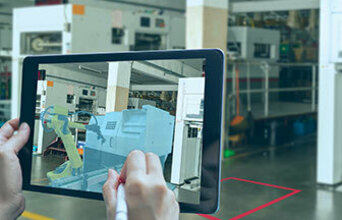
With a changing technology landscape and business dynamic, the manufacturing world faces a unique challenge - manufacturing plants don't know what to do with the data that flows through their systems. Most factories today have adopted digitisation and follow a seamless digital operational flow. There is a gamut of data flowing through their systems and tools on the factory floor. Some are converted into relevant information, while the remaining is left without further investigation. Unfortunately, organisations do not know what to do with this remaining set of data. The question is how to translate this information and where to use it.
In the manufacturing industry, cement companies were one of the first adopters of automation and used digitised sensors and signals. Even manufacturing plants with heavy machinery and assets have been using automation for over a decade. Despite this, there is no set path to analysing 100 per cent data and utilising it to reduce costs and increase production efficiency. This is where artificial intelligence-powered hyper-automation can become a game-changer for the manufacturing world.
According to Global AI in Manufacturing Industry Trends, the market is estimated to reach $78,744 million by 2030, up from $2,963 million in 2021. The report suggests there is a growing need for artificial intelligence because of the demand for enhanced productivity and automation in the facilities. A recent Forbes survey on AI also mentions that about 44 per cent of automotive manufacturing companies rated AI as extremely important to production in the next five years, while 49 per cent said it was critical to success. Yet, more than half of automotive respondents (56 per cent) said they plan to increase AI expenditure by less than 10 per cent.
Artificial intelligence and hyper-automation can offer increased efficiencies, reduced costs, improved quality and reduced downtime, and these benefits together can change the manufacturing industry for the better. It is a one-stop solution for a well-informed and faster decision-making process. Let us see how.
PREDICTIVE MAINTENANCE
Since manufacturing systems are flowing with data, evaluating the historic data from maintenance logs can help preempt and predict maintenance issues and even design failures. From analysing when it needs fixing to when it should be stopped for resting, all of it can be assessed through AI intervention. The problem that AI is solving here is predicting the downtime of the production line in advance and notifying the manager so that maintenance is done immediately. While human calculations have been great, it's not enough to stop a system from failing. All of this can be managed seamlessly by the intervention of an AI-powered hyper-automation platform, which, in the end, will reduce downtime significantly.
QUALITY CHECK
Manufacturing work is all about precision. Attention to detail is critical, especially in the electronics space. Historically, quality checks have always happened manually. However, it creates the chances of human error. With the help of AI-driven computer vision, the job becomes easier. Maintaining quality checks becomes automatic and in real-time with AI.
AUTOMATING ASSEMBLY LINES
Every manufacturing unit has multiple dashboards continuously receiving data day in and day out. Since most systems and equipment are digitised, each piece of equipment generates a vast amount of data that gets stored on the cloud. However, not all data gets utilised, and neither does the operations manager get a holistic picture of the activities happening in the back end. Therefore, the operation manager needs to go through multiple dashboards to get a clear picture. But it is next to impossible for one or even a few human beings to read all the data, analyse and then decide the right course of action. Someone rightly called it "death by dashboards". Through hyper-automation, a manufacturer can automate the assembly lines, collect data from every nook and corner of the system and get a unified view of operations. Furthermore, this data can create alerts and notifications in real-time. When a system breaks down, the operations manager will get notified immediately and set in motion the contingency plan fed into the system.
INDUSTRIAL ROBOTS FOR EFFICIENCY
Industrial robots are not replacing humans. But they facilitate a human's job by creating efficiency. A robot in a manufacturing plant can help reduce production costs, along with protecting its workers. From monitoring signals in control rooms to material handling, assembly, and even inspection, AI-enabled industrial robots can automate tasks.
DEMAND AND INVENTORY FORECASTING
It is a huge task for manufacturing plants and facilities to manage inventory. Despite digitising bookkeeping systems and people keeping track, the chances of delays and misses are big. Integrating artificial intelligence can generate a plan for inventory management and forecasting demand. It can easily update stock status and order value and notify inventory forecasts.
HOW CAN WE DEPLOY AI?
So implementing AI cannot happen suddenly and not on all parameters in one go. A unit needs to be identified, and within that, a problem statement should be created on which AI-driven solution must be tried. A pilot run is essential here. Also, not one solution will fit all production/machine lines. Each will need a specific solution. The best way to work up AI-driven hyper-automation is to create customised solutions, and this will also prove to be cost-effective for any organisation. One should also invest in data unification - that's the beauty of AI, and can work like a charm in the manufacturing industry.
AI'S THE FUTURE
Hyper-automation can change the manufacturing industry for the better. The idea is to create an autonomous manufacturing unit that can be scaled with ease. From improving equipment uptime to increased bottom lines and better profit-earning opportunities, there are multiple reasons why AI and hyper-automation are beneficial for the industry. Not only does it make taking actionable decisions faster and more accurate, but it also understands anomalies and notifies in real-time. For manufacturers, AI can be a game changer enabling quality, efficiency, price management, employee management, and production management on one platform. There has never been a better time for the industry to change than now.



























